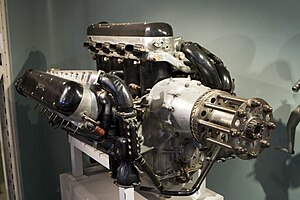Napier Lion
| Lion | |
|---|---|
 |
|
| Napier Lion II at Canada Aviation Museum | |
| Type | Piston aero-engine |
| Manufacturer | D. Napier & Son |
| First run | 1917 |
| Major applications |
Handley Page Hyderabad Vickers Vernon |
The Napier Lion was a 12-cylinder 'broad arrow' W12 configuration aircraft engine built by D. Napier & Son from 1917 until the 1930s. A number of advanced features made it the most powerful engine of its day and kept it in production long after other contemporary designs had been superseded. It is particularly well known for its use on a number of racing designs, in aircraft, boats and cars.
Early in the First World War, Napier were contracted to build aero engines to designs from other companies, initially a Royal Aircraft Factory model and then Sunbeams. Both engines proved to be unreliable and in 1916 Napier decided to design an engine with high power, light weight and low frontal area. Napier's engineers laid out the engine with its 12 cylinders in what they called a "broad arrow"—three banks of four cylinders sharing a common crankcase. This suggested the design's first name, the Triple-Four. The configuration is also known as a W engine. The engine was also advanced in form, the heads using four valves per cylinder with twin overhead camshafts on each bank of cylinders and a single block being milled from aluminium instead of the common separate-cylinder steel construction used on almost all other designs.
Under Arthur Rowledge, the design of the engine, renamed Lion, was completed in 1917 and hand-built prototypes ran later that year. It was fitted to an Airco DH.9 in early 1918 and many cooling problems were observed during testing. The milled block was difficult to build with the required accuracy and the design reverted to separate aluminium cylinders. Both problems were solved by the middle of the year and the engine entered production in June 1918. The first Lion I versions delivered 450 horsepower (340 kW) from their 24 litres. The power output made the Lion the most powerful Allied aircraft engine, which had previously been the Liberty L-12, which produced 400 horsepower (300 kW).
...
Wikipedia
